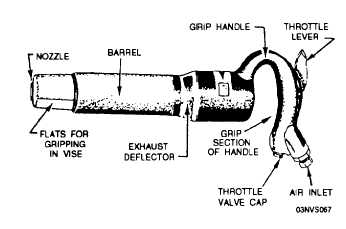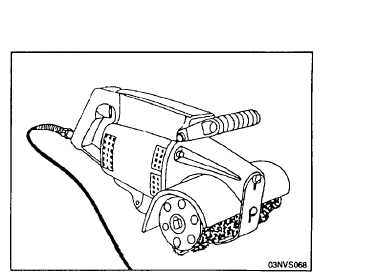PORTABLE PNEUMATIC
POWER TOOLS
Portable pneumatic power tools are tools that look
much the same as electric power tools but use the
energy of compressed air instead of electricity.
Because of the limited outlets for compressed air
aboard ship and shore stations, the use of pneumatic
power tools is not as widespread as electric tools.
Portable pneumatic tools are used most around a shop
where compressed air outlets are readily
PNEUMATIC CHIPPING HAMMER
The pneumatic chipping hammer
accessible.
(fig. 1-67)
consists basically of a steel piston that is reciprocated
(moved backward and forward alternately) in a steel
barrel by compressed air. On its forward stroke the
piston strikes the end of the chisel, which is a sliding
fit in a nozzle pressed into the barrel. The rearward
stroke is cushioned by compressed air to prevent any
metal-to-metal contact. Reciprocation of the piston is
automatically controlled by a valve located on the rear
end of the barrel. Located on the rear end of the
barrel is a grip handle, containing a throttle valve.
The pneumatic hammer may be used for beveling;
caulking or beading operations and for drilling in
brick, concrete, and other masonry.
Chipping hammers should not be operated without
safety goggles, and all other persons in the immediate
vicinity of the work should wear goggles.
While working, never point the chipping hammer
in such a direction that other personnel might be
struck by an accidentally ejected tool. When chipping
alloy steel or doing other heavy work, it is helpful to
Figure 1-67.-Pneumatic chipping hammer.
dip the tool in engine lubricating oil about every 6
inches of the cut and make sure the cutting edge of
the tool is sharp and clean. This will allow faster and
easier cutting and will reduce the possibility of the
tool breaking.
When nearing the end of a cut, ease off on the
throttle lever to reduce the intensity of the blows.
This will avoid any possibility of the chip or tool
flying.
If for any reason you have to lay the chipping
hammer down, always remove the attachment tool
from the nozzle. Should the chipping hammer be
accidentally started when the tool is free, the blow of
the piston will drive the tool out of the nozzle with
great force and may damage equipment or injure
personnel.
ROTARY AND NEEDLE
IMPACT SCALERS
Rotary and needle scalers (figs. 1-68 and 1-69) are
used to remove rust, scale, and old paint from metallic
and masonry surfaces. You must be especially careful
when using these tools since they will “chew” up
anything in their path. Avoid getting the power line
or any part of your body in their way.
The rotary scaling and chipping tool, sometimes
called a “jitterbug,” has a bundle of cutters or chippers
for scaling or chipping (fig. 1-68). In use, the tool is
pushed along the surface to be scaled, and the rotating
chippers do the work. Replacement bundles of cutters
are available when the old ones are worn.
Figure 1-68.- Rotary impact scaler.
1-40



